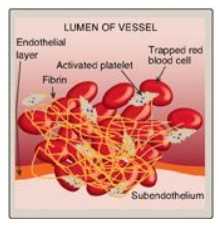Overview of Blood clotting
| Home | | Biochemistry |Chapter: Biochemistry : Blood clotting
Blood clotting (coagulation) is designed to rapidly stop bleeding from a damaged blood vessel in order to maintain a constant blood volume (hemostasis).
Blood clotting
OVERVIEW
Blood clotting (coagulation)
is designed to rapidly stop bleeding from a damaged blood vessel in order to
maintain a constant blood volume (hemostasis). Coagulation is accomplished
through vasoconstriction and the formation of a clot (thrombus) that consists
of a plug of platelets and a meshwork of the protein fibrin that stabilizes the
platelet plug. Clotting occurs in association with membranes on the surface of
platelets and damaged blood vessels (Figure 34.1). [Note: If clotting occurs
within an intact vessel such that the lumen is occluded and blood flow is
impeded, a condition known as thrombosis, serious tissue damage and even death
can occur. This is what happens, for example, during a myocardial infarction
(MI).] Processes to limit clot formation to the area of damage and remove the
clot once vessel repair is underway also play essential roles in hemostasis.
[Note: Separate discussions of the formation of the platelet plug and the
fibrin meshwork facilitate presentation of these multistep, multicomponent
processes. However, the two work together to maintain hemostasis.]

Figure 34.1 A blood clot
formed by a plug of activated platelets and a meshwork of fibrin at the site of
vessel injury.
Related Topics
